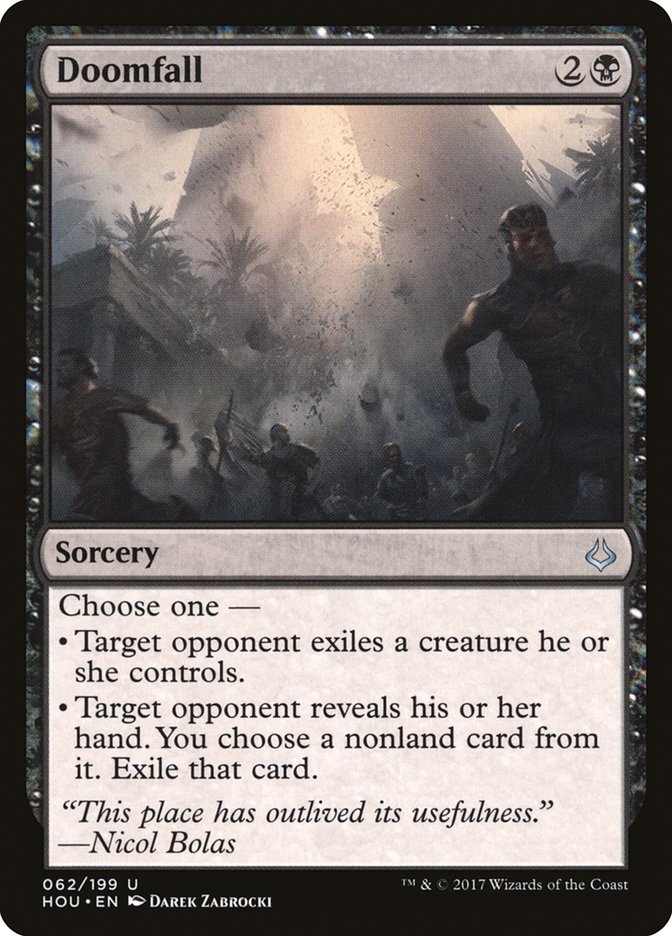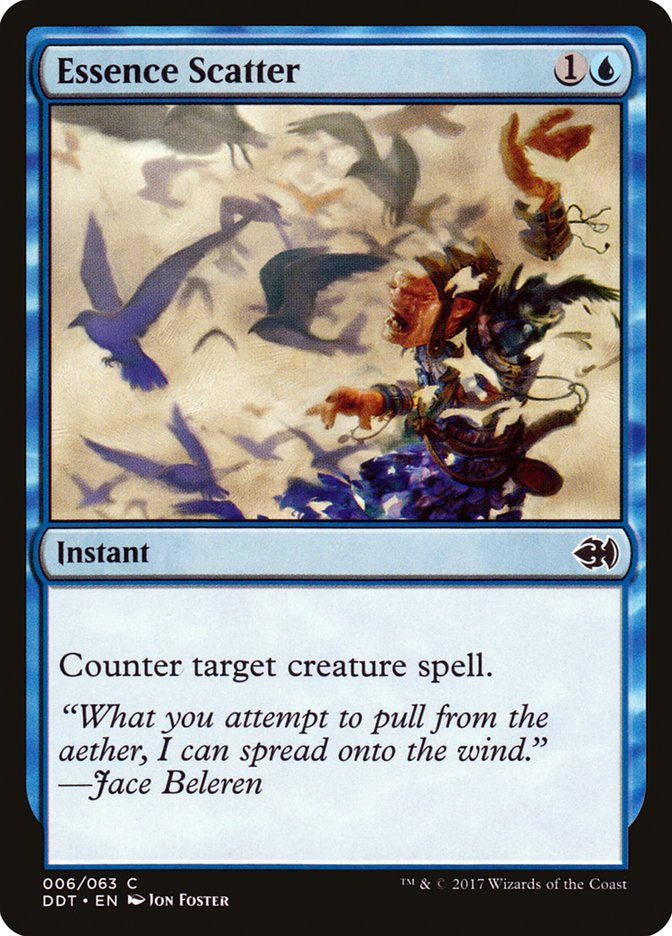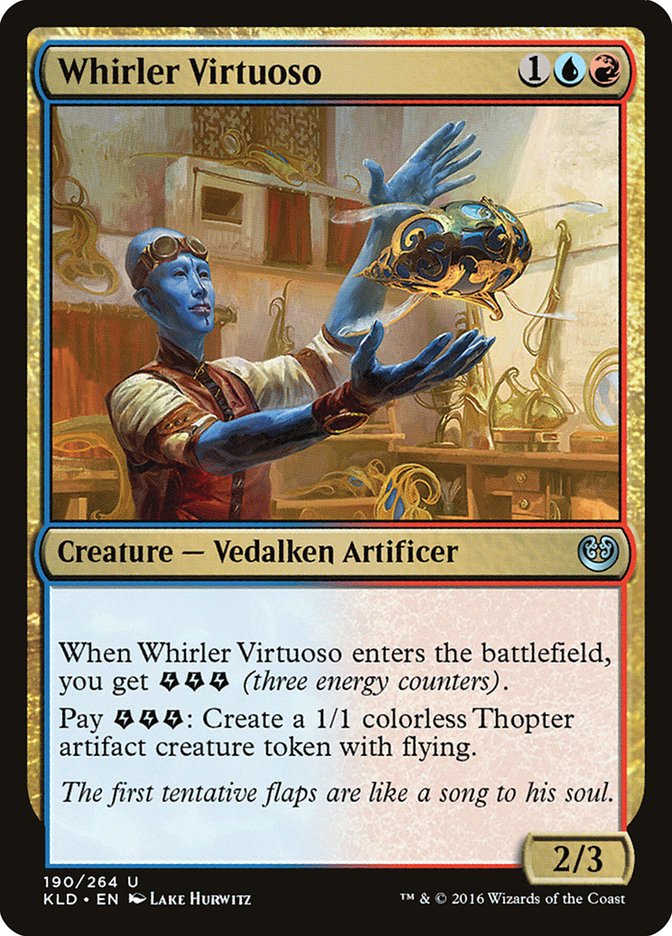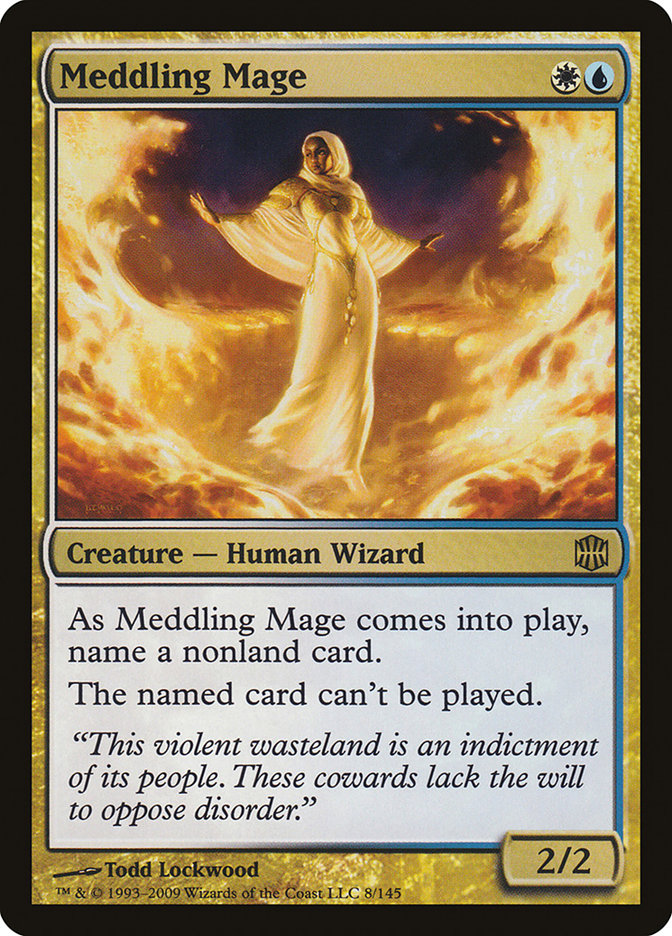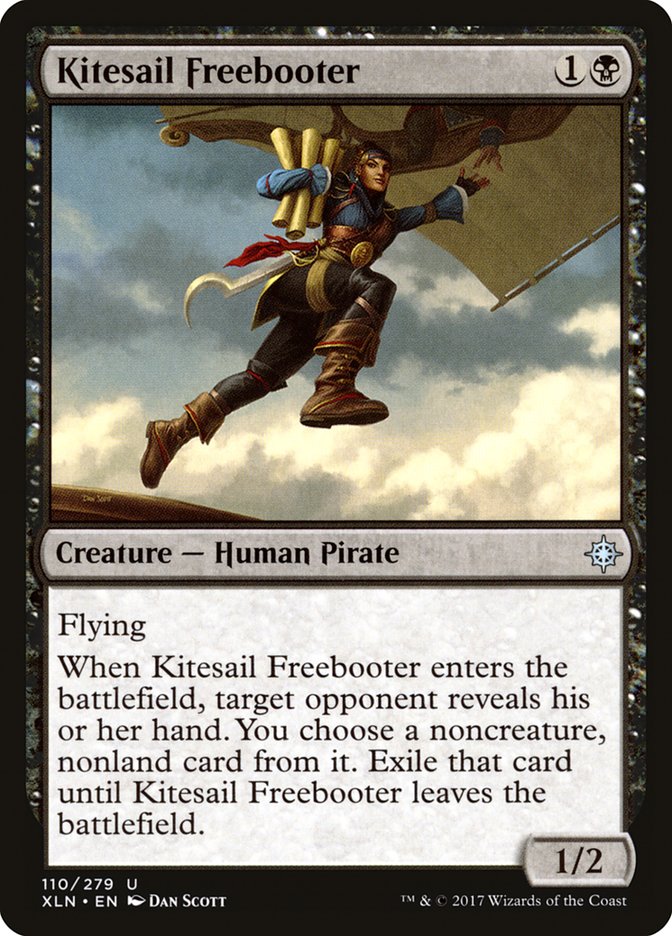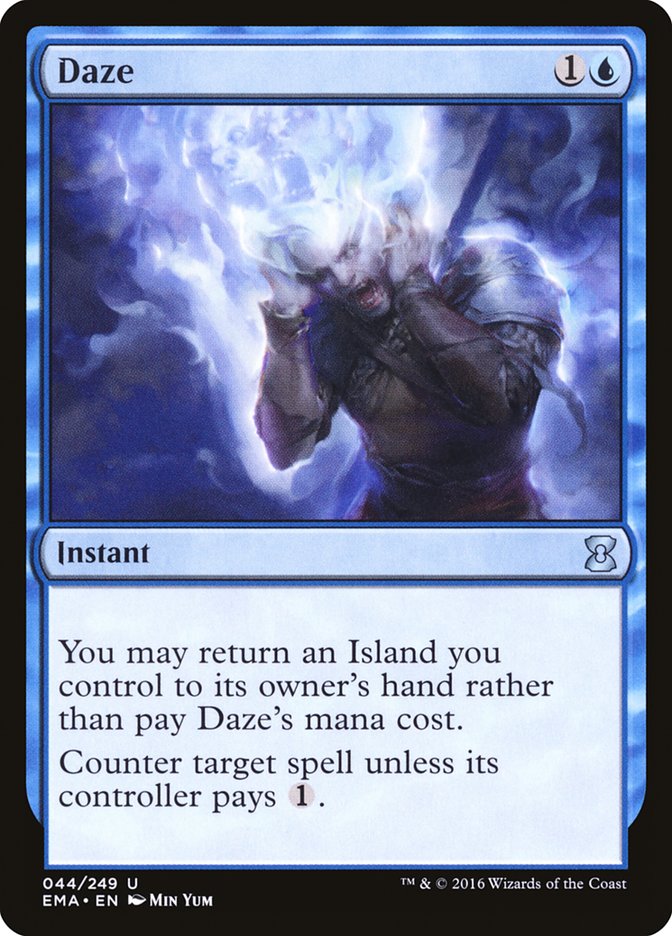1. Grixis Energy is the Standard deck to beat at SCG
Cincinnati.
Ryan Overturf: Fact.
Standard is actually pretty interesting right now, and there are more
viable strategies than there have been in some time. That said, energy
remains a low maintenance mechanic with an extremely high pay off.
Harnessed Lightning is just Doom Blade and Whirler Virtuoso still has the
ability to shut down aggressive strategies relatively easily. On top of
that, the deck just gets to play The Scarab God, which figures to be the
best individual card in Standard.
The deck is beatable, has exploitable weaknesses, and honestly doesn’t have
the most stable manabase. Even still, not preparing for it would be
foolish. Grixis Energy isn’t so good that it is incorrect not to play it,
but it’s certainly good enough that you need a reason to be playing
something else.
Patrick Sullivan: Fiction.
I think it is more important to have a plan for U/B decks, generally, and
The Scarab God, specifically, than it is to beat Grixis Energy. What struck
me about Christopher Green’s winning list from Grand Prix Madrid was how
well-suited he was for the mirror and other The Scarab God strategies: a
full playset of Vraska’s Contempts, two Confiscation Coups, filling out the
random removal with cards that actually function against The Scarab God,
etc. It is hard to argue that he’s gunning for Grixis Energy
specifically-in fact, the main deck Doomfall is probably costing him a
little bit in the mirror. But he’s aware of what card he has to beat, and I
think Standard players would be wise to follow that lead.
Keep in mind: beating The Scarab God in its various shells isn’t just about
playing a bunch of counterspells and spot removal that exiles; you can beat
down, too. The winning Grixis Control deck is taking some liberties with
its Red matchup Game 1-it has Whirler Virtuoso, a couple cheap removal
spells, and a whole lot of nonsense, and the sideboard isn’t exactly
overflowing with haymakers, either. If the metagame becomes a sea of U/B
decks trying to win The Scarab God fights, my advice would be to go
underneath all of that and attack early and often.
2. Five-Color Humans is the Modern deck to beat at SCG
Cincinnati.
Ryan Overturf: Fiction.
Humans is a deck that should be on your radar right now with Steve Locke’s
Grand Prix win in Phoenix. More than that though, if I were preparing for a
Modern tournament, I would want a plan for Bloodbraid Elf. I can’t speak to
the format at large, but I know that my Snapcaster Mage decks feel
miserably bad against basically every Bloodbraid Elf deck, with the
exception of maybe Ponza. The format at large has less of a Bloodbraid Elf
problem than the decks that I prefer do, but even still I have to figure
that Jund is currently public enemy number one.
It is true that Locke defeated Pierson Laughlin on Jund in the finals of
Phoenix, but I have a very hard time believing that this was representative
of the matchup. Jund placed second both in that Grand Prix as well as in
the Dallas Classic, and Star City Games’ own Jadine Klomparens took the
deck to a Top 8 finish at the Dallas Open. Bloodbraid Elf gave Jund a very
powerful endgame that can generate a lot of damage from nowhere while also
providing card advantage and a good amount of redundancy. I often refer to
Thoughtseize as “the Modern Force of Will,” and Jund is currently by far
the best deck at breaking up opposing gameplans with this tool while also
employing a powerful beatdown plan.
Patrick Sullivan: Fiction.
I almost always think the answer to this question is “Fiction” when it
comes to Modern; the card pool is so vast and people play so many decks
that trying to metagame for one particular deck is almost always an error.
If I had to key in on a single deck right now, I would probably select
Jund-people love playing “good stuff” decks, and Jund is legitimately
powerful with the unbanning of Bloodbraid Elf. Beating that deck isn’t as
simple as adding one high-leverage sideboard card.
Humans is still great, and it’s important to know that beating them isn’t
as simple as having one good sweeper. The deck is so hostile to spells with
Kitesail Freebooter, Meddling Mage, Thalia, Guardian of Thraben, and
additional options in the sideboard. Spot Removal + sweepers isn’t a bad
path; Grim Lavamancer + removal might be better. Still, I’ve seen too many
people lean on a bunch of Supreme Verdicts and assume the matchup is fine,
and if you go down that road, it won’t be.
3. Grixis Delver is the Legacy deck to beat at SCG
Cincinnati.
Ryan Overturf: Fact.
This was something of a foregone conclusion when Sensei’s Divining Top was
banned in Legacy and tournament results have demonstrated this to be the
case. I may be guilty of some Delver bias, but honestly the current
incarnations of Delver strategies are simply not my cup of tea. I posted an
immaculate 0-2 record at Monday night Legacy this week with Drake Sasser’s
winning 75 from the Worcester Open, but despite my struggles with the
archetype, Sasser and others are absolutely dominating with the deck.
Grixis Delver is definitely beatable. Ben Feingersh may have lost the
finals to Sasser in Worcester, but you’d better believe he demolished other
Delver players en route. I also believe that decks like
Jim Davis’ Top 4 Miracles build
from that tournament can be difficult matchups, and that’s only just
scratching the surface of the format.
Patrick Sullivan: Fact.
This discussion is over until there’s a banning or some destabilizing card
enters the format. People want to narrow the discussion down to which key
card is causing the issue, but it’s the chorus of everything-how well it
operates while light on resources along with how well it attritions out the
game, how Deathrite Shaman + cantrips makes it so that being tight on mana
or flooded is very unlikely, how well the deck operates on the play and on
the draw, how powerful and flexible the sideboard is. I’ve felt that Daze +
Wasteland + the best proactive one mana threats is the best way to approach
Legacy for at least the last half-decade, and Deathrite Shaman along with
Gurmag Angler has cemented black as the best color to pair along with that
shell.
All is not hopeless-I think Lands has a positive (if somewhat overrated)
matchup against Grixis Delver, and the Delver lists I watched in Worcester
seemed well short on cards for Elves. But Grixis Delver is so efficient,
ruthless, and powerful that it approaches 50% even in matchups that are
hostile towards it. If I wanted to try something unorthodox, I think Jim
Davis was onto something in Worcester-a lot of basic lands, Swords to
Plowshares, and Terminus strikes me as a promising foundation for an
anti-Delver strategy.
4. The Scarab God should be banned from Standard.
Ryan Overturf: Fiction.
The Scarab God is not the most heinous mistake that has slipped through the
cracks lately, though it certainly was a mistake. It’s just one of those
cards that is pushed in every way and when it ends up being as good as it
is, the optics are terrible because it would have been totally reasonable
to lower the power level of the card in any number of ways. That said, the
players that I’ve spoken to lately seem to like the current format a lot.
Banlist updates must not be made lightly, and ultimately the “butts in
seats” metric tends to be the decider. If players are playing, then things
couldn’t be that bad. I don’t have stats for everywhere, but Standard
attendance has recovered significantly at my store since the most recent
set of bannings. It’s also fair to say that it’s just going to take time
for the format to fully recover after what a disaster things have been
lately.
That last point is going to be what I believe is the most important reason
to not take further action with regard to banning cards in Standard. The
dust just hasn’t had that much time to settle, and you can’t just
constantly sweep the rug out from under players. The timelines on Standard
rotations are short enough as it is. If you give players a format that is
generally fine, which I believe this format to be, they’ll start to trickle
back. If you give them an excellent format then they’ll come back faster,
but this circumstance has to be reached organically to have the best
results.
Patrick Sullivan: Fiction.
I mean, I get it. Patrick Chapin once described The Scarab God to me as
“one of the best seven mana creatures of all time,” and while that’s maybe
a little hyperbole you are getting this thing on quite a discount. It can
be obnoxious as hell to throw a bunch of removal spells at it just to delay
the inevitable, and even one activation can be enough advantage to run away
with the game even if the other player has an answer. Scan the recent
winning lists in Standard and you see a bunch of copies of it and a ton of
removal that’s informed largely by this card and this card alone; if you
factor in ubiquity and play pattern there’s a more compelling case here
than with some cards that actually were banned in the last two years.
Still, I’ve been harping on the lack of viable Baneslayer Angels in
Standard for a long time, and while The Scarab God isn’t exactly Baneslayer
Angel (one of the defining elements of Baneslayer is that you can kill it
pretty easily and move on), there are some similarities-The Scarab God asks
you to take some risk and commit mana on your own turn, it does inform card
selection on the other side of the table, it usually takes at least a turn
or two of controlling it for things to get really good for its controller,
it’s a control card that gets the game over with fairly quickly, and so on.
On the balance, I would rather have The Scarab God be where the power
points are than something like Torrential Gearhulk, and I would like a
higher bar applied to Standard bans in general.
5. Deathrite Shaman should be banned from Legacy.
Ryan Overtuf: Fact.
I’m going to do something moronic here and argue against a man beloved for
his game design knowledge. He’s going to have a really clever rant and
probably include the phrase “at least it has a textbox” and probably talk
about how the play patterns for Wasteland are super miserable by
comparison, and if he wants to he can even mention the farce that is
Brainstorm’s legality. There’s a lot of truth to that, and while I feel
Wasteland is a nice safeguard against the innumerable oppressive lands that
are legal in the format, ultimately my argument is strictly an indictment
of Deathrite Shaman itself.
Deathrite Shaman is a phase one card that both accelerates you to phase
three by virtue of mana acceleration while also having abilities that scale
exceptionally well into phase three. I said earlier that The Scarab God is
a card where literally every part of the card feels exceptionally pushed,
but Deathrite Shaman is the poster child for this. Getting access to mana
acceleration plus graveyard hate on a one mana creature is frankly
embarrassing for Noble Hierarch–a card that still sees some play in the
format! Beyond that though, the fact that this mana Elf is castable off of
Underground Sea is obscene, and the second point of toughness feels like a
cruel joke at the expense of Goblin Lackey. The impact that Deathrite
Shaman has when uncontested on the early turns of the game is already a
huge return on a one-mana investment, but then it’s also just a great card
in the late game on top of this.
The warping effect of Deathrite Shaman in Legacy is undeniable. The
majority of successful decks are either combo decks or Deathrite Shaman
decks. Sometimes both! It’s too low maintenance to be as impactful as it is
for one mana, and it’s really hard to justify not playing your own
Deathrite Shamans. Legacy is pretty divorced from the banlist philosophy of
other formats and as such I’m not sure if or when we’ll be seeing action on
Deathrite Shaman, especially since all the while cards like Brainstorm and
Wasteland are allowed to remain ubiquitous. All I know is that I’ve found
the play patterns to be particularly unpleasant and that I would be happier
if the card left the format than just feeling like I need to play it for my
deck to be any good.
Patrick Sullivan: Fiction.
I understand the argument here, as well. There is a feeling that this card
just does too much-too easy to cast, too much rate, too much flexibility,
too hostile towards graveyard strategies. It costs one mana, so it’s hard
to argue that its adding power to Legacy in a way that is different from
the other best stuff. It is gross alongside both Daze and Wasteland, and
it’s hard to argue that those cards needed more support. And just look at
the results-Grixis Delver is obviously the best and most popular deck, so
why not take some percentage points out of there?
I take the other side of that debate for a variety of reasons. I dislike
curating a banned list by giving some stuff a pass just because it’s been
around for long enough and then banning around it, because the root
problematic cards are just going to surround something else. Daze,
Wasteland, cantrips, the best one mana threats-this shell has been the best
or nearly the best thing in Legacy for as long as I’ve been playing the
format. What happens if you ban Deathrite Shaman and then Temur Delver
becomes the best thing instead? What happens if you ban Deathrite Shaman
and there’s a new good delve threat or juiced one-drop in a Commander
product? Maybe Deathrite is so oppressive to graveyards that banning it
opens up new decks (I’ve never really bought this argument), but I’m
skeptical it ushers in an appreciably different world.
I also like the card. Maybe it would be nice if it was toned down a little
bit, but so much of Legacy is just manipulating your draw step and trying
to efficiently exchange removal, and Deathrite Shaman is something
different. It has a text box [confetti and game show celebration-Ed.], it’s dynamic from turn
to turn, provides options, opportunities for counterplay. It helps decks
cast somewhat expensive spells, not an easy task in a format with Wasteland
and turn 2 kills. Deathrite Shaman is in many ways very different from the
types of cards that show up in Legacy, and usually to make something like
that happen you’re giving a pass on rate.
If I was forced to ban something out of Legacy, my choice would be Ponder.
It is so much about the manipulating of draw steps and exchanging of
material, it is laborious to resolve (to say nothing of waiting for your
opponent to resolve it), there are no shortage of reasonable replacements
if you just want Good Cantrips 5-8, and it would help take some percentage
points out of Delver strategies. Deathrite Shaman might be a bit much but
at least it’s a little different; Ponder is also a bit much and is all
about the same stuff.


